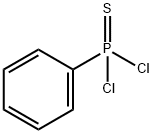Phenylthiophosphonic dichloride is a thiophosphonate and has been used to prepare high-refractive-index materials.
Colorless liquid with unpleasant acrid pungent odor. Corrodes metals slowly.
Flammable. Decomposes to give hydrochloric acid in water, although this reaction is slow. The reaction becomes vigorous if the water is hot.
PHENYLTHIOPHOSPHONIC DICHLORIDE is water reactive. Incompatible with strong oxidizing agents, alcohols, amines, alkali. Contact with active metals generates flammable hydrogen gas. May react vigorously or explosively if mixed with diisopropyl ether or other ethers in the presence of trace amounts of metal salts [J. Haz. Mat., 1981, 4, 291].
CORROSIVE and/or TOXIC; inhalation, ingestion or contact (skin, eyes) with vapors, dusts or substance may cause severe injury, burns or death. Fire will produce irritating, corrosive and/or toxic gases. Reaction with water may generate much heat that will increase the concentration of fumes in the air. Contact with molten substance may cause severe burns to skin and eyes. Runoff from fire control or dilution water may cause pollution.
EXCEPT FOR ACETIC ANHYDRIDE (UN1715), THAT IS FLAMMABLE, some of these materials may burn, but none ignite readily. May ignite combustibles (wood, paper, oil, clothing, etc.). Substance will react with water (some violently), releasing corrosive and/or toxic gases and runoff. Flammable/toxic gases may accumulate in confined areas (basement, tanks, hopper/tank cars, etc.). Contact with metals may evolve flammable hydrogen gas. Containers may explode when heated or if contaminated with water. Substance may be transported in a molten form.
A corrosive. When heated to decomposition it emits toxic vapors of SOx and POx.

